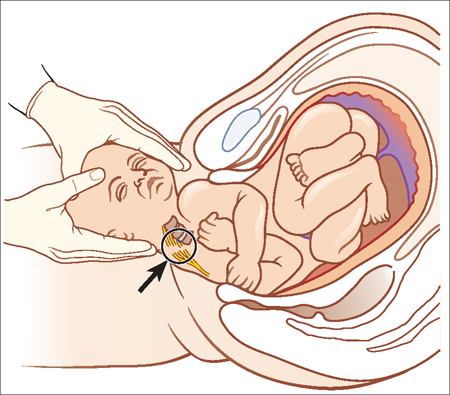27 Post-Term Pregnancy E. Albert Reece A typical pregnancy lasts approximately nine months but can vary between 37 and 42 weeks and still produce a normal, healthy baby. On average, however, women give birth at approximately 40 weeks, or 280 days, from the first day of their last menstrual period. Just as babies who are born preterm can have significant and long-lasting health problems, so can babies who stay too long in the womb. Indeed, a pregnancy that continues beyond 42 weeks is associated with adverse consequences for both the fetus and the mother. Thus, any physician caring for a pregnant woman who has passed her due date must have a management plan in place to prevent such complications from occurring. The World Health Organization defines post-term, or prolonged, pregnancy as one that exceeds 42 completed weeks (294 days or more) from the onset of the last menstrual period (LMP). Ideally, an accurate gestational age is determined early in the pregnancy. However, variations in when a woman ovulates can lead to errors in calculating the true duration of pregnancy and to overestimation or underestimation of when the baby is due. Traditionally, a woman’s LMP was used to calculate the estimated due date (EDD). This typically involved using a pregnancy wheel (Fig. 27.1), in which the date of the patient’s LMP was lined up with that date on the wheel, and an indicator on the wheel was used find the corresponding EDD. However, this method of dating a pregnancy is subject to many inaccuracies, particularly among women who have irregular cycles, have been on recent hormonal birth control, or who have first trimester bleeding. Numerous studies have shown that dating a pregnancy early on via ultrasonography significantly improves the reliability of the EDD. However, the margin of error increases during each trimester of gestation. If an ultrasound scan is performed before 20 weeks’ gestation, the margin of error is about 1 week. Between 20 and 30 weeks’ gestation, the margin of error may increase to as much as 2 weeks. After 30 weeks’ gestation, the margin of error may exceed 2 weeks. In general, the margin of error is usually assumed to be 2 weeks. Thus, a pregnancy that is dated at 35 weeks’ gestation by ultrasonography could actually be anywhere from 33 weeks to 37 weeks. A gestational age calculated by composite biometry from a sonogram (see below) must be considered only an estimate. Fig. 27.1 A standard pregnancy wheel used to determine an estimated due date. A great deal of controversy surrounds the prevalence of post-term pregnancies, with estimates ranging from 3% to 14% of all pregnancies. Because of inaccuracies in dating pregnancies, many “pseudo” post-term pregnancies, in fact, are not post-term. Thus, it is important to accurately determine when a pregnancy begins, because errors in dating often lead physicians to deliver so-called term pregnancies prematurely, or to unnecessarily allow pregnancies to continue that are actually post-term. Inaccurate dating of conception is the most frequent cause of post-term pregnancy. However, there are other factors that can predispose a woman to carry a fetus past 42 weeks of gestation. These include primiparity, prior post-term pregnancy, the gender of the fetus (males are more likely to be post-term than females), and genetic factors. Studies of monozygotic and dizygotic twins and their subsequent development of prolonged pregnancies have found that maternal, but not paternal, genetic factors influence the rate of post-term pregnancies and account for in as many as 30% of these pregnancies. A pregnancy that continues beyond 42 weeks is associated with significant adverse consequences to the fetus and the mother. The following provides an overview of the most common consequences. Pregnancies that continue beyond an actual 42 weeks of gestation have an increased risk of stillbirth or infant death. However, the increased risk is relatively small, with only 4 to 7 deaths per 1000 deliveries compared with 2 to 3 deaths per 1000 deliveries among women who deliver between 37 and 42 weeks. On the other hand, true post-term fetuses do have a greater chance of developing complications related to larger body size, or macrosomia, which is defined as weighing more than 4500 g, or about 10 pounds. Complications for the fetus can include prolonged labor, difficulty passing through the vagina, and birth trauma (e. g., fractured bones or nerve injury) related to shoulder dystocia (Fig. 27.2). Post-term fetuses sometimes develop fetal dysmaturity syndrome—also called “post-maturity syndrome”— in which the fetus’ growth in utero is restricted due to a problem with delivery of blood via the placenta. This puts the fetus at increased risk for umbilical cord compression in utero as well as problems after delivery, including long-term breathing and neurologic abnormalities. One of the more severe consequences of a post-term pregnancy involves the fetus having a bowel movement of meconium into the amniotic fluid. If the fetus becomes stressed, it can inhale some of this meconium-contaminated amniotic fluid, which can cause breathing problems or infection when it is born. Adverse consequences to the mother of a post-term fetus are related to the larger size of the infant, and include difficulties during labor, an increase in injury to the perineum (including the vagina, labia, and rectum), and an increased rate of cesarean birth with its associated risks of bleeding, infection, and injury to surrounding organs. Fig. 27.2 Shoulder dystocia occurs when the infant’s anterior shoulder has difficulty passing below the pubic symphysis, or significant manipulation is required to get it to pass. A number of symptoms warrant an immediate evaluation in a woman who is nearing the term of her pregnancy or is suspected of being post-term. These include any perceived decrease in fetal movements or loss of fluid or any pain or other discomfort that appears abnormal.
Definition
Diagnosis

Prevalence
Etiology
Pathophysiology
Fetal Consequences
Maternal Consequences

History
Chief Complaints
Physical Examination
Antenatal Fetal Monitoring
Stay updated, free articles. Join our Telegram channel

Full access? Get Clinical Tree


